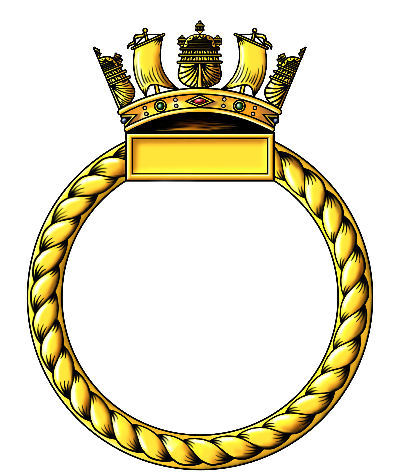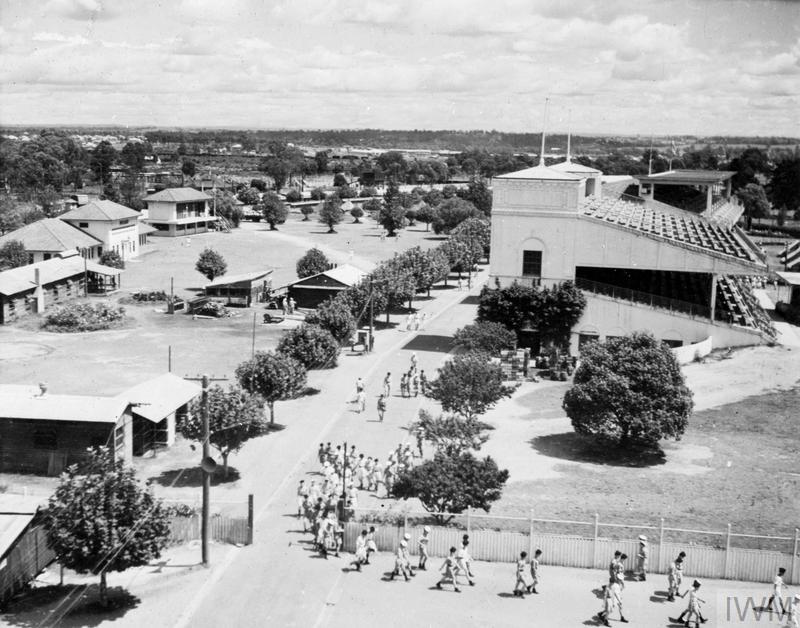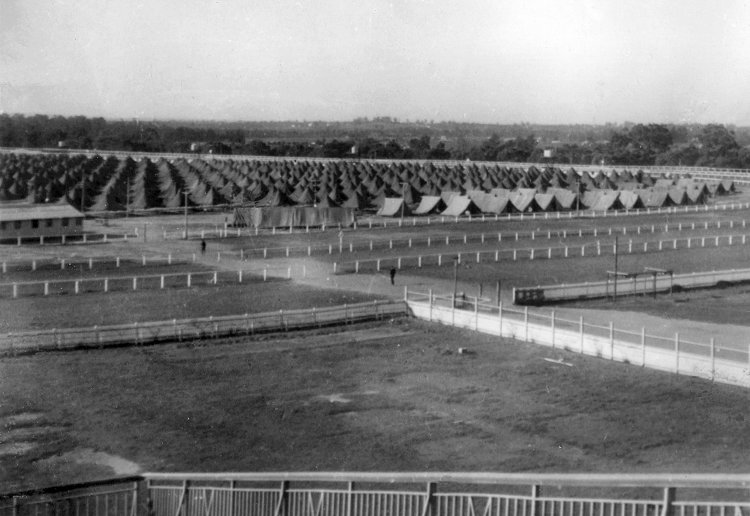R.N. Barracks and Accounting Base

No badge issued for this vessel
Battle Honours
None
Specifications
Locations
Headquarters: Hargreaves Park, Liverpool, Sydney, New South Wales. Australia.
Barracks: Warwick Farm Racecourse, Liverpool, Sydney, New South Wales. Australia.
Function: RN Barracks, RN Accounting Base, H.Q. Flag Officer Naval Air Australia, H.Q. Vice Admiral (Q) BPF (post war)
Commanding Officers
Commodore H. B. Crane
(Commodore 2nd Class. In Command and Commodore R.N.B., Sydney.) Dec 1944
Related items
None
Reminiscences
None
H.M.S. GOLDEN HIND

General view of the main buildings at Royal Naval Barracks, Warwick Farm Racecourse, Liverpool, Sydney, H.M.S. GOLDEN HIND; on the right is the grandstand, used as a canteen, the guard room and main gate lower left. The Commodore’s office is the uppermost building on the left. Photo: © IWM (A 29253)
History
In November 1944 the Australian government began transferring military bases and facilities to the Admiralty in preparation for the arrival in Australian waters of the newly formed British Pacific Fleet. On November 20th 1944 HMS GOLDEN HIND commissioned as an RN Accounting Base and headquarters at the former American army camp at Hargrave Park, Liverpool, Sydney, New South Wales. The Headquarters camp comprised of wooden huts, with additional accommodation being completed in the early part of 1945. A Barracks & Drafting Pool was established on the opposite side of the railway line, at the nearby Warwick Farm racecourse; this was a huge tented camp which occupied the centre of the racecourse. Here the naval personnel arriving from the UK were accommodated while awaiting passage to join the BPF at Manus or elsewhere.
HMS GOLDEN HIND was also the headquarters of the Flag Officer Naval Air Stations (Australia) (F.O.N.A.S. Australia), Rear-Admiral R. H. Portal, DSC, who had responsibility for all Fillet Arm related matters including the drafting of large numbers f Fleet Air Arm personnel that were to pass through the Barracks on route to Air Stations in Australia and for the fleet carriers and support vessels.
Responsible for other RN units in Australia
With the exception of HMS BEACONSFIELD in Melbourne, all Royal Navy faculties in Australia were initially under the control of HMS GOLDEN HIND; some establishment were later commissioned with their own ship names, but their accounting was still done by GOLDEN HIND. In Brisbane this included an Auxiliary Hospital, an R.N. Depot and the vessels of the Brisbane Escort Force; the R.N. Depot Brisbane commissioned as HMS FURNEAUX on April 1st. In Sydney accounts were carried for an R.N. Auxiliary Hospital and R.N. Depot, Woolloomooloo. Personnel of the British Pacific Fleet Intermediate Base, at Manus, were also carried on the books of Golden Hind from February 1945 until it commissioned as HMS PEPYS on October 1st 1945.
A Royal Marine Training Base was opened in April 1945 when the former Royal Australian Navy base at Nelson Bay, New South Wales, (ex HMAS ASSAULT) was given to the Royal Navy and administered by GOLDEN HIND. In May 1945 an RN Repair Base was opened at Garden Island, this was originally to be GOLDEN HIND II but the base was commissioned as HMS WOOLLOOMOOLOO on July 1st 1945. The name GOLDEN HIND II however appears to have been used post-war when the accounts of personnel in Hong Kong from December 1945, and Tokyo from January 1st 1946, appear as GOLDEN HIND II. In addition to being responsible for administering the Harbour Service Craft and Rescue Tugs in the Sydney area, GOLDEN HIND also resumed responsibility for the R.N. Depots at Woolloomooloo and Brisbane (once paid off).

he tented city that covered most of the race course at Warwick Farm, Royal Naval Barracks, Sydney. Non-commissioned ranks were housed in bell tents, Officers in ridge tents. Photo: Alan Starling
Post War
After the Japanese surrender the Warwick Farm racecourse barracks became transit camp for personnel from the fleet awaiting passage home. Vice Admiral J. W. Rivett-Carnac, CBE, DSC, Vice Admiral (Admin) British Pacific Fleet relocated to GOLDEN HIND on December 1st 45 when the BPF headquarters at Port Melbourne, HMS BEACONSFIELD, was Paid Off. On March 19th 1946 the Drafting Pool relocated to Colombo, when the camp at Warwick Farm Racecourse closed. The Hargrave Park H.Q. site was also closed at the end of March, and relocated to offices at Carrier Buildings, Bourke St Woolloomooloo; the site was transferred to the Housing Commission for conversion into an emergency housing centre for about 1,000 families.
From March 31st 1946 to June 6th 1946 the accounts of personnel in establishments in Sydney, WRNS Quarters Sydney and seagoing tenders became GOLDEN HIND III; on June 7th 1946 it reverted to GOLDEN HIND. HMS GOLDEN HIND made one final move on April 22nd 1946 to the 10th Floor, Grace Building, York St, Sydney, where it remained until January 31st 1947 when it was Paid Off.
Last modified: 23 February 2023
Primary information sources
Additional sources:
Jones, D. & Nunan, P. (2005) 'U.S. subs down under: Brisbane, 1942-1945' Naval Institute Press, Annapolis
Special thanks to Mr.. Michael Steemson, son of Commander John F. Steemson R.N., for his help in researching this history.

Comments (12)
I have a letter that was written to my father,
R. McBrien (Elect Artificer), number C/MX 18712.
H.M.S Golden Hind (Staff),
c/o GPO,
London.
The letter was franked on 17-Sept-1945 in Brighton, Sussex.
I do know that father was part of the crew onboard the RMS Aquitania that would have departed the UK during October 1945 and arriving at Sydney on the date of the attached photograph.
My question is, does that HMS Golden Hind refer to the camp in Australia or was there a camp by the same name in London, UK?
As father was an Electrical Engineer in Civvy Street before WWII, he was involved with the operation of the Anti Mine Belt that was fitted to the RMS Aquitania prior to her voyage to Australia.
Regards Chris McBrien.
My grandad was at golden hind . A second lieutenant in the Royal Marines .
My father was there between 13 Sep and 25th Nov 45. Family legend has it that he was there after being torpedoed and spent several weeks in an open boat, I haven't been able to get to the bottom of that one but I do know he was befriended by a family called Salisbury.